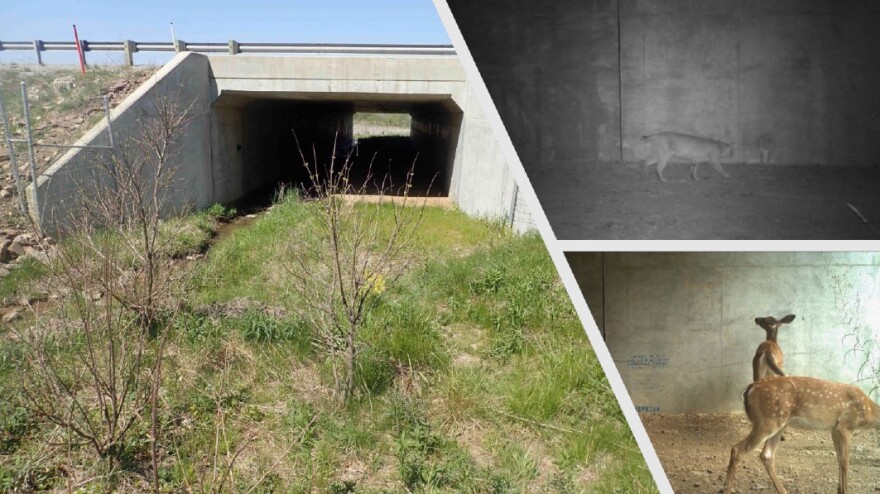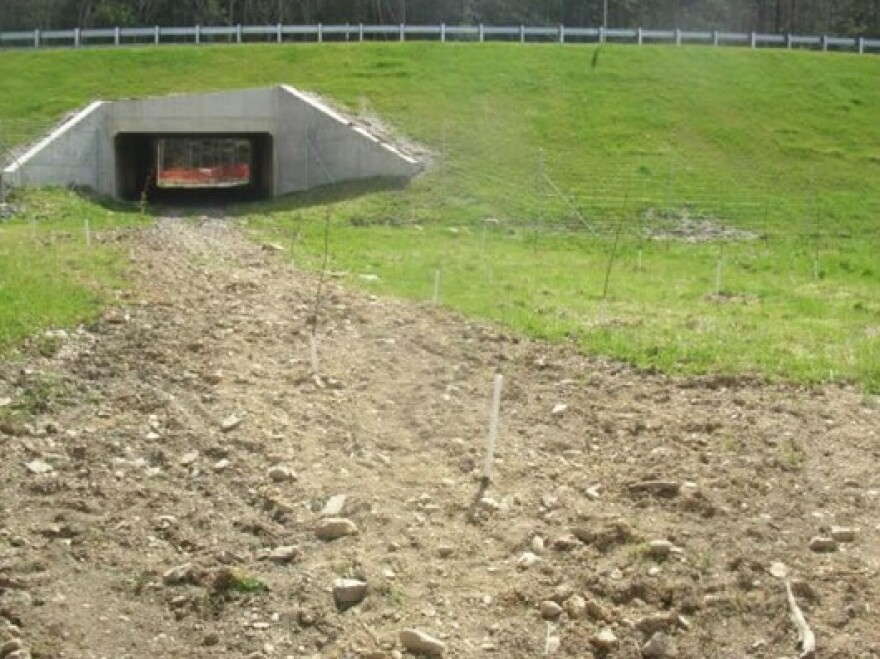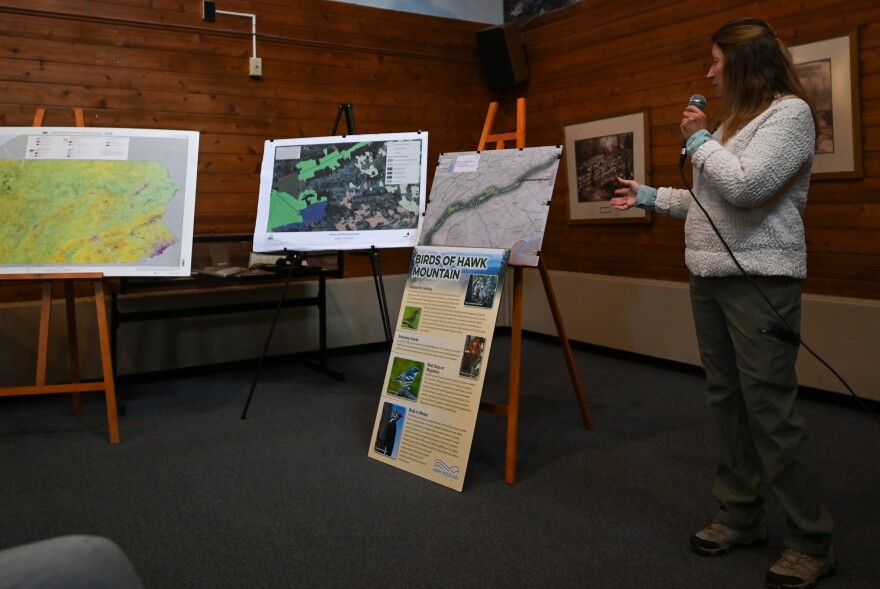Why did the wood frog cross Hawk Mountain Road during the first warm rains of spring?
At Hawk Mountain Sanctuary, the amphibian slowly crosses the road to get to a vernal pool to breed.
"It's typically like one night or over a couple night(s) window,” said Sean Grace, sanctuary president.
Spotted salamanders, which can live for 20 years, also cross the road.
"And if you have something like nine cars an hour, it's like an 80 or 90% mortality," he said.
The sanctuary, which straddles Schuylkill and Berks counties, was the world's first refuge for birds of prey. But it's home to more than just birds. On Nov. 6, representatives from PennEnvironment joined Hawk Mountain leadership to push for a statewide plan to help establish wildlife corridors across the state to protect animals, like amphibians. In March, the organization's Research and Policy Center released a study on Pennsylvania Wildlife Corridors, or lack thereof.
PennEnvironment is an advocacy organization that promotes clean air, clean water, clean energy, wildlife and open spaces and a livable climate.
Pennsylvania has no cohesive plan for addressing wildlife corridors, according to the organization. In June 2024, the Legislative Budget and Finance Committee did a study on the Current Status of Conservation Connectivity in Pennsylvania.
“Despite the lack of official Pennsylvania public policy regarding the development of conservation corridors, we found many state agencies and independent commissions implementing conservation connectivity practices,” according to the state study.
PennEnvironment backed that study.

Animal crossing

Wildlife corridors provide safe passage for animals during their migrations. It could be a bridge over a busy highway for deer, a tunnel under a local road for bears, or, in the case of the frogs and salamanders at Hawk Mountain, a tiny culvert under the state and township road complete with tiny fences to guide the cold-blooded creatures to safety.
"It enhances survival of those species, both plant and wildlife, and in general, is just a healthier environment,” Dr. Laurie Goodrich, director of conservation science, said.
The 2,600-acre sanctuary is surrounded by Pennsylvania game lands and forest land and Federal National Park Service land. It's also considered a wildlife corridor.
"The total protected block of forest that we have ... is over 15,000 acres, and it's highly important habitat,” Goodrich said.
Todd Bauman is the sanctuary's director of Stewardship. He said wildlife corridors are not just lines on a map.
"They are living pathways that sustain biodiversity. Protecting them ensures the species can move, adapt and thrive in the face of ongoing change,” he said.

Roads, development divide habitats
PennEnvironment found that last year, around 147,000 collisions happened with large animals. In 2021, over 500 black bears died on Pennsylvania’s roadways and 60 of the state’s 1,400 elk were killed by vehicles. In 2023, State Farm Insurance Company ranked Pennsylvania No. 1 in the nation for the number of auto insurance claims filed for animal-vehicle collisions.
Stephanie Wein, PennEnvironment’s water and conservation advocate, stood near Hawk Mountain Road, which cuts through the sanctuary to connect the sides of the mountain.
It’s where the amphibians are killed every spring. Goodrich said some raptors, like owls on the hunt, and larger mammals heading down to the Little Schuylkill River have also been hit and killed.
Wein gave an example from Fayette County of why a statewide plan is needed.
PennDOT repaired a road in the Indian Creek Reservoir. While inspecting the road ahead of the work, employees noticed a ton of dead amphibians.
The reservoir is run by the Fish and Boat Commission. PennDOT worked with the commission to put little underpasses beneath the road. When they went back after a year or two, they saw no road mortality, Wein said.
But PennDOT employees just happened to notice that a crossing was needed, she said.
"And the reason that that's happening is because there is no statewide wildlife crossing or corridor plan coming down from the state level," she said. "There's all this data on where these mortalities are happening. Imagine if that was used ahead of time to cite the best places to put some of these crossings. And so that's the policy change the PennEnvironment is calling for.”
Habitats split
In early November, northwest winds were blowing, Goodrich said. Bald and golden eagles passed by the sanctuary's lookouts along with red-tailed hawks, sharp-shinned hawks, purple finches and other song birds.
Hawk Mountain is considered a stopover habitat. It's part of two critical corridors — the Kittantiny Ridge, where migrating raptors and songbirds travel from Canada to the southern United States, and the Appalachian Trail, which provides continuous forests for species from Maine to Georgia.
Goodrich said its a highway that about 20,000 hawks a year, and over 50,000 songbirds travel. When property is up for sale near the sanctuary, they try to buy it.
Because roads are not the only issue impacting animal migration.
Habitat loss and fragmentation is the number one threat to wildlife in Pennsylvania, said Hanna Felber, PennEnvironment's clean water and conservation associate.
“Each year, more and more of the state's wildlife habitat is criss crossed by roads, energy infrastructure, sprawling development and other projects that fragment our wilderness, making it harder for Pennsylvania's native species to roam, migrate, mate, hunt and forage, and the problem of habitat loss is only accelerating,” she said.
Felber said it causes inbreeding, loss of habitat types, interrupted migration, decreased climate resilience and adds to the amount of animals hit and killed by cars.
The birds don't just fly over the sanctuary.
At the south lookout, a group of students from the University of Pennsylvania painted watercolor landscapes as three eagles circled above. The birds were so high that they looked like three dark shapes floating in the wind.
"If you're a big raptor like an eagle, you really need to save energy as much as possible. So they're saving energy by using the wind currents that are created along the ridge," Goodrich said. "And in addition to that, it's because of the habitat. There's so much abundant habitat here that the birds can then, when they need to sit down easily, find a place to rest and feed.”
She said they found that hawks will sit and rest for two or three hours at the sanctuary.
The area isn't just for birds.
"Rattlesnakes or amphibians go down to the low lying areas to lay their eggs, to have their young, and then migrate back up the mountain after that, into the forest," she said. "So both landscapes or habitats are integrals to this whole corridor.”

Too many agencies
Hawk Mountain Road is both a state and township road. Sanctuary leaders say it takes a lot of coordination to improve the route.
“So that would require that coordination between all those officials, as well as significant grant support to make that happen. It's a complex challenge, but one we remain open to exploring and with partners,” Bauman said.
Wein believes there’s a few reasons why Pennsylvania doesn’t have a statewide plan, including that the state has more government agencies to collaborate across than most states.
Another reason is that Pennsylvania isn’t home to one specific species that may be endangered.
She used Florida as an example. They have the endangered Florida panther that roams massive ranges.
"The extraordinary work that Florida does to connect habitats across that state is there's this iconic species that it all sort of revolves around," Wein said. "But then when you build the corridors for panthers, you're also building them for everything else.”
Pennsylvania does have elk but they roam mostly in the state’s northcentral region, called the PA Wilds.
"There's big, charismatic species that we definitely need to protect. But there hasn't sort of been that one species that sort of united all of Pennsylvania.”
'Now is the time to act'
There's been no movement on establishing a statewide plan for wildlife corridors since the state legislature.
State Rep. Mary Jo Daley, a Democrat from Montgomery County, was the prime sponsor on the house bill that directed the study of wildlife corridors.
In 2024, Daley said its been nearly a decade of legislative efforts to create a study on conservation corridors.
She helped release PennEnvironment's report on the issue.

“Together, these reports paint an extremely in-depth look at the realities Pennsylvania faces conserving critical habitat for its wilderness,” Daley said. “We have the most roads out of any state in the Northeast. We also have crisscrossed pipelines, mines, canals and developments running all over the state. Balancing our footprint with the animals that have called this part of the Earth home for centuries is a step toward better environmental health, harmony and safety.”
State Rep. Jason Ortitay, a Republican from Washington and Allegheny counties, was a co-sponsor.
"Now is the time to act," he said.
For a longtime, leaders from Hawk Mountain Sanctuary has wanted a statewide plan.
"To have something that's cohesive coming down from the top, identifying the key spots and hopefully linking to funding, would be super," said Goodrich.





